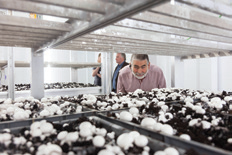Teagasc’s new mushroom research unit was open to visitors on 17 May. The unit was completed this year by JF McKenna and is a scaled down version of a modern Dutch shelf mushroom production facility, with full environmental climate control and steam sterilisation. Current trials are mainly focussed on improving our understanding of crop genetics and trying to improve yield, particularly in the third flush. Teagasc is a world leader in MVX research and currently, our disease research is concerned with how different varieties of Agaricus bisporus react to MVX infection. The mushroom research unit works hand in hand with our diagnostic laboratories where a disease diagnostic service is currently available through our mushroom advisor, Donal Gernon.
In terms of research direction, an opportunity exists to increase the sophistication and complexity of the mushroom product portfolio in the context of significant advances in mushroom science, particularly the completed genome sequencing of Agaricus bisporus. The genome sequence will expedite mushroom breeding for improved agronomic characteristics, but more importantly for a new product portfolio.
Ultimately, a strong focused research and development programme is required to build resilience in a sector which is exposed to external and internal economic factors such as the Sterling exchange rate, labour costs, and general increasing input costs. There is an existing drive in the industry to diversify away from the single commodity based enterprise to look at new exciting future products, such as animal/human feeds and supplements, bioactive compounds, myco-packaging, mushrooms as a chitin source, biomedical (ABL lectin) and using mushrooms as a meat replacer in burgers and processed meat products.
From Teagasc’s perspective, we are interested in further analysis of the genes that we believe to be involved in controlling mushroom production, for example seeing what genes are turned on and off as the mushroom mycelium is colonising the compost. Having more information here could help reduce the crop cycle, leading to higher turnover of crops and better profits. ✽










